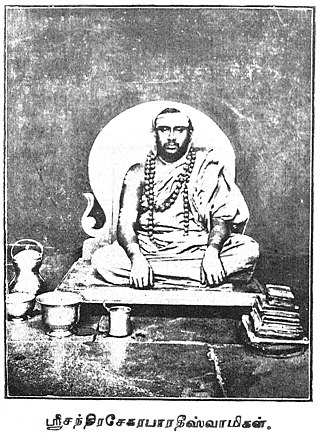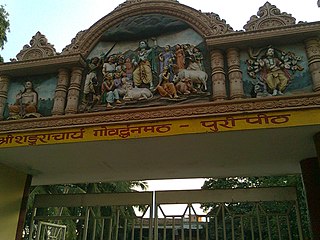
Sringeri also called Shringeri is a hill town and Taluk headquarters located in Chikkamagaluru district in the Indian state of Karnataka. It is the site of the first maṭha established by Adi Shankara,Hindu theologian and exponent of the Advaita Vedanta philosophy. Located on the banks of the river Tungā,the town draws a large number of pilgrims to its temples of Sri Sharadamba,Sri Vidyashankara,Sri Malahanikareshvara and other deities.

Shankaracharya is a religious title used by the heads of amnaya monasteries called mathas in the Advaita Vedanta tradition of Hinduism. The title derives from Adi Shankara;teachers from the successive line of teachers retrospectively dated back to him are known as Shankaracharyas.
Sri Kanchi Kamakoti Peetham,also called the Sri Kanchi Matham or the Moolamnaya Sarvagnya Peetham,is a Hindu religious center of Vedic learning,located in Kanchipuram,Tamil Nadu. It is housed at the Kamakshi Amman Temple of the Shaktism tradition,which also contains a shrine for the Advaita Vedanta teacher Adi Shankara.

Dakṣiṇāmnāya ŚrīŚāradāPīṭham or Śri Śṛṅgagiri Maṭha is one amongst the four cardinal pīthams following the Daśanāmi Sampradaya - the peetham or matha is said to have been established by acharya ŚrīĀdi Śaṅkara to preserve and propagate Sanātana Dharma and Advaita Vedānta,the doctrine of non-dualism. Located in Śringerīin Chikmagalur district in Karnataka,India,it is the Southern Āmnāya Pītham amongst the four Chaturāmnāya Pīthams,with the others being the DvārakāŚāradāPītham (Gujarat) in the West,PurīGovardhana Pīṭhaṃ(Odisha) in the East,Badri Jyotishpīṭhaṃ(Uttarakhand) in the North. The head of the matha is called Shankarayacharya,the title derives from Adi Shankara.

Swami Chandrasekhara Bharati was the Jagadguru Sankaracarya of Sringeri Sharada Peetham in 1912–1954. He was one of the known spiritual figures in Hinduism during the 20th century. He is a Jivanmukta.

PascimāmnāyaŚrīŚāradāPītham or Dwarka Sharada Math,is one amongst the four cardinal peethams believed by its followers to be established by Adi Shankara,preserving and propagating Sanatana Dharma and Advaita Vedanta,the doctrine of non-dualism. Located in the city of Dwaraka,Gujarat,India it is the pascimāmnāya matha,or Western Āmnāya Pītham amongst the four Chaturāmnāya Pīthams. It is also known as the KālikāMatha. Their Vedantic mantra or Mahavakya is Tattvamasi. According to tradition,believed to be initiated by Adi Shankara,it holds authority over Sama Veda. The head of the matha is called Shankarayacharya,the title derives from Adi Shankara.

Purvamnaya Sri Govardhana Pitham or Govardhan Math is one amongst the four cardinal pithams established by the philosopher-saint Adi Shankara to preserve and propagate Hinduism and Advaita Vedanta,the doctrine of non-dualism. Located in Puri in Odisha,India,it is the Eastern Āmnāya Pītham amongst the four pithams,with the others being the Sringeri Śārada Pīṭhaṃ(Karnataka) in the South,DvārakāŚāradāPītham (Gujarat) in the West,Badari Jyotirmaṭha Pīṭhaṃ(Uttarakhand) in the North .It is associated with the Jagannath temple. Their Vedantic mantra or Mahavakya is Prajñānam brahma and as per the tradition initiated by Adi Shankara it holds authority over the Rigveda. The head of the matha is called Shankarayacharya,the title derives from Adi Shankara.

Sri Sharadamba Temple is a famous Hindu temple dedicated to goddess Sharadamba in the holy town of Sringeri in Karnataka,India.
Saraswati P. Venkataraman Sastri,hieratically titled H.H. JagadguruShankaracharya Swami Bharatikrishna Tirtha (1884–1960),was Shankaracharya and officiating pontiff of Dwaraka Math,and then the 143rd Shankaracharya and supreme pontiff of Govardhana Math in Puri in the Indian state of Odisha,from 1925 through 1960. He is particularly known for his book Vedic Mathematics,being the first Sankaracarya in history to visit the West,and for his connection with nationalist aspirations,thus earning him the title 'Father Of The Vedic Maths'.

Sthānika Brāhmins belong to Hindu Tuluva Smartha Brahmin group.
Sacchidananda Bharati I,was a Hindu sant and religious leader of the 17th century. He was the Jagadguru of the Hindu matha Sringeri Sharada Peetham from 1623 to 1663,and is believed to have saved it from attack by spiritual means.
Malladi Chandrasekhara Sastry was an Indian scholar and television personality who specialized in the Vedas and Puranas texts in the Telugu and Sanskrit languages. His works have included commentaries on All India Radio during Bhadrachalam's Sitarama Kalyanam and Brahmotsavam festivals. For Ugadi day,he recited the Panchanga Sravanam. On television he hosted a show Dharma Sandehalu and Dharma Sukshmalu where he answered questions regarding the Purana and various aspects of Hinduism. The show is telecast on the Sri Venkateswara Bhakti Channel and formerly on the Doordarshan Saptagiri Channel. He was the principal of a college run by the trust named Tirumala Tirupati Devasthanams where they do pravachan (lectures) on the Puranas. He received the Raja-Lakshmi Award in 2005,and has also been conferred the title of Purana Vachaspati.
Nallakunta is a neighbourhood in Hyderabad,India.
The Kasi Visalakshi Viswanathar temple is in the village of Kunnuvarankottai,which is a neighbourhood in Dindigul in the State of Tamil Nadu in India. This village is served by three rivers —Vaigai,Maruda and Manjalaru —called the Triveni Sangam. The river Vaigai takes a slightly northern course near this village,like the Ganges takes at Varanasi.

The Advaita Guru-Paramparā is the traditional lineage (parampara) of divine,Vedic and historical teachers of Advaita Vedanta. It begins with the Daiva-paramparā,the gods;followed by the Ṛṣi-paramparā,the Vedic seers;and then the Mānava-paramparā,with the historical teachers Gaudapada and Adi Shankara,and four of Shankara's pupils. Of the five contemporary acharyas,the heads of the five Advaita mathas,four acharyas trace their lineage to those four pupils and one to Adi Shankara himself.

Uttarāmnāya ŚrīJyotish Pītham or JyotirMath is one amongst the four cardinal pīthams established by the Ādi Śaṅkara to preserve Hinduism and Advaita Vedānta,the doctrine of non-dualism. Located in the city of Joshimath,Chamoli district,Uttarakhand,India,it is the uttarāmnāya matha or Northern Āmnāya Pītham,amongst the four Chaturamnay Peethams and in later period,Moolamnaya Sarvajna Peetham was declared as Moolamnay by disciples which is in Kalady,Kerala,birth place of Adi Shankara with the others being the Sringeri Śārada Pīṭhaṃ(Karnataka) in the South,DvārakāŚāradāPītham in the West and PurīGovardhanmaṭha Pīṭhaṃin the east. Its appointees bear the title of Shankaracharya. It is the headquarters of Giri,Parvata &Sagara sects of the Dasnami Sampradaya. Their Vedantic mantra or Mahavakya is Ayamātmānam brahma and as per the tradition initiated by Adi Shankara it holds authority over Atharva Veda. The head of the matha is called Shankaracharya,the title derives from Adi Shankara.
Jnanananda Bharati (1889–1975),also spelled Gnanananda Bharati,was a Sanyasi,lawyer,philosopher,writer and author. Born as Krishnaswamy Iyer to Vakil G. Ramachandra Iyer and Janaki Ammal on 26 October 1889,Krishnaswamy passed his BA,MA and BL degrees at the University of Madras and practiced as a successful lawyer at Tirunelveli.

Bharathi Tirtha Mahaswamiji,,is an Indian religious leader who is the current and 36th Shankaracharya of Sringeri Sharada Peetham,an important Hindu monastery in the tradition of Advaita Vedanta established by Sri Adi Shankara.
C. S. Yogananda is a mathematician and Professor of Mathematics at J.S.S Science and Technology University[1] in Mysore,India. He received his Ph.D. from The Institute of Mathematical Sciences,Chennai under advisor Ramachandran Balasubramanian.[2][3] He is an entrepreneur[4] and author[5][6] who has published several writings on mathematics.

Tummalapalli Ramalingeswara Rao was a Telugu poet,novelist,literary critic,philosophical journalist,writer of English prose and an exponent of Mantra Shastra and tradition. His works covered a wide range of subjects like history,sociology,literature,philosophy,religion and spiritualism. His popular works include Sri Lalitha Sahasranama Stotra Bhashyamu,Sri Chakra Vilasanamu,Sri Chakra Pooja Vidhanam,Dharmanirnayam,Tikkana Somayaji,Sivanugrahamu Pitruyagnamu (Poetry) and Sringeri Revisited.













